basis of behaviour to develop more
effective shark repellents
Repelling white sharks with lights and sounds

Sharks are often seen as a threat to humans
and, as a result, there is increasing interest in developing shark
mitigation devices. In this
study, we assessed the effects of an intense strobe light and
artificial sound on shark behaviour.
When presented alone, and in combination with sound, the
lights reduced the number of times that the bait was taken.
The strobe light alone,
however, did not affect the behaviour of white sharks, but when
presented in combination with sound, white sharks spent
significantly less time in proximity to the bait.
The world's first proven shark deterrent device
 Personal
shark deterrents are being marketed as the solution to mitigate the
threat that sharks pose. However, the effectiveness claims of
many personal deterrents are based on our knowledge of shark sensory
biology rather than robust testing of the devices themselves, as
most have not been subjected to independent scientific studies.
Here we tested the
effectiveness of the commercially available shark deterrent device,
the Shark Shield. The
results of this study provide the first quantitative evidence of the
effectiveness of a non-lethal electric shark deterrent.
Personal
shark deterrents are being marketed as the solution to mitigate the
threat that sharks pose. However, the effectiveness claims of
many personal deterrents are based on our knowledge of shark sensory
biology rather than robust testing of the devices themselves, as
most have not been subjected to independent scientific studies.
Here we tested the
effectiveness of the commercially available shark deterrent device,
the Shark Shield. The
results of this study provide the first quantitative evidence of the
effectiveness of a non-lethal electric shark deterrent.
Electrosensory driven feeding behaviours in sharks and rays
 Elasmobranch
fishes (sharks, skates and rays) possess a highly sensitive
electrosensory system that enables them to detect weak electric
fields, such as those produced by potential prey organisms. Despite
several comparative anatomical studies, the functional significance
of interspecific variation in electrosensory system morphology
remains poorly understood. The results of this investigation suggest
that differences in abundance and distribution of electrosensory
pores have little to no effect on the absolute electrical
sensitivity in elasmobranchs, and instead, may reflect
species-specific differences in the spatial resolution and
directionality of electroreception.
Elasmobranch
fishes (sharks, skates and rays) possess a highly sensitive
electrosensory system that enables them to detect weak electric
fields, such as those produced by potential prey organisms. Despite
several comparative anatomical studies, the functional significance
of interspecific variation in electrosensory system morphology
remains poorly understood. The results of this investigation suggest
that differences in abundance and distribution of electrosensory
pores have little to no effect on the absolute electrical
sensitivity in elasmobranchs, and instead, may reflect
species-specific differences in the spatial resolution and
directionality of electroreception.
The visual specialisations of stingrays
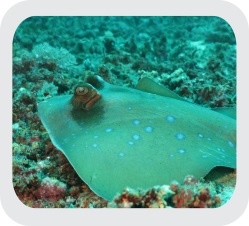 The
eyes of five ray species (Taeniura lymma, Neotrygon kuhlii,
Pastinachus atrus, Himantura uarnak and Urogymnus
asperrimus) from the same taxonomic family (Dasyatidae) and the
same geographic region (Ningaloo Reef, Western Australia) were
studied to identify differences in retinal specialisations
that may reflect niche specialization. The
main specialisation in the retinal cell density distribution is the
dorsal streak that allows these animals to scan the substrate for
potential prey. Visual specialisations in different species,
although subtle, may reflect species specific ecological niches.
The
eyes of five ray species (Taeniura lymma, Neotrygon kuhlii,
Pastinachus atrus, Himantura uarnak and Urogymnus
asperrimus) from the same taxonomic family (Dasyatidae) and the
same geographic region (Ningaloo Reef, Western Australia) were
studied to identify differences in retinal specialisations
that may reflect niche specialization. The
main specialisation in the retinal cell density distribution is the
dorsal streak that allows these animals to scan the substrate for
potential prey. Visual specialisations in different species,
although subtle, may reflect species specific ecological niches.
Understanding the role of electroreception in sharks and rays
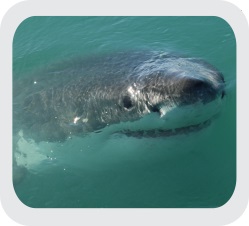 Improving
our understanding of how various elasmobranch species sense and
interact with their environment using electroreception has distinct
commercial applications through the development of electric shark
repellents used to protect ocean users from aggressive encounters
with sharks. In addition, the identification of specific
electrosensory cues that may repel elasmobranchs may also lead to
effective solutions for reducing bycatch and improving the
efficiency of fisheries.
Improving
our understanding of how various elasmobranch species sense and
interact with their environment using electroreception has distinct
commercial applications through the development of electric shark
repellents used to protect ocean users from aggressive encounters
with sharks. In addition, the identification of specific
electrosensory cues that may repel elasmobranchs may also lead to
effective solutions for reducing bycatch and improving the
efficiency of fisheries.
Research Paper: Kempster RM (2014) The role of electroreception in elasmobranchs. Ph.D. Thesis, University of Western Australia, Australia.
Comparison of the
wobbegong and angel shark electrosensory system
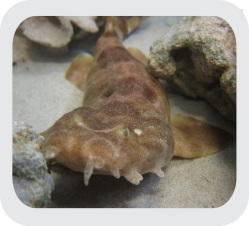
Wobbegong
sharks and angel sharks represent two distantly related families
that have independently evolved a similar dorso-ventrally compressed
body form to complement their benthic ambush feeding strategy.
Consequently, these groups represent useful models in which to
investigate the specific morphological and physiological adaptations
that are driven by the adoption of a benthic lifestyle. In this
study, we compared the distribution and abundance of electrosensory
pores in the spotted wobbegong shark (Orectolobus
maculatus)
with the Australian angel shark (Squatina
australis)
to determine whether both species display a similar pattern of
clustering of sub-dermal electroreceptors and to further understand
the functional importance of electroreception in the feeding
behaviour of these benthic sharks.
Comparison of stingray electrosensory morphology
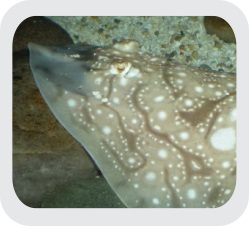
The electrosensory system is found in all
chondrichthyan fishes and is used for several biological functions,
most notably prey detection. Variation in the physical parameters of
a habitat type, i.e. water conductivity, may influence the
morphology of the electrosensory system. Thus, the electrosensory
systems of freshwater rays are considerably different from those of
fully marine species; however, little research has so far examined
the morphology and distribution of these systems in euryhaline
elasmo-branchs. The present study investigates and compares the
morphology and distribution of electrosensory organs in two
sympatric stingray species: the (euryhaline) estuary stingray,
Dasyatis fluviorum, and the (marine) blue-spotted maskray,
Neotrygon kuhlii. This study indicates that the morphology of
the electrosensory system in a euryhaline elasmobranch species seems
very similar to that of their fully marine counterparts. However,
some morphological differences are present between these two
sympatric species, which are thought to be linked to their habitat
type.
Stingray mates feel the electricity

Quantitative studies of sensory axons provide invaluable insights into
the functional significance and relative importance of a particular
sensory modality. Despite the important role electroreception plays
in the behaviour of elasmobranchs, to date, there have been no
studies that have assessed the number of electrosensory axons that
project from the peripheral ampullae to the central nervous system
(CNS). To fully appreciate the function of the electrosensory
system, it is essential to assess the neural network that connects
the peripheral system to the CNS. Using stereological techniques,
unbiased estimates of the total number of axons were obtained for
both the electrosensory bundles exiting individual ampullary organs
and those entering the CNS (via the dorsal root of the anterior
lateral line nerve, ALLN) in males and females of different sizes.
The dorsal root of the ALLN consists solely of myelinated
electrosensory axons and shows both ontogenetic and sexual
dimorphism. In particular, females exhibit a greater abundance of
electrosensory axons, which may result in improved sensitivity of
the electrosensory system and may facilitate mate identification for
reproduction.
Associated media coverage: Phys.org, The Australian...
Predator Avoidance in Shark Embryos
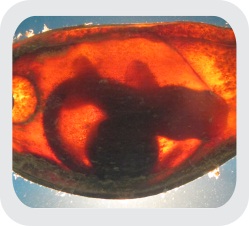 Sharks
use highly sensitive electroreceptors to detect the electric fields
emitted by potential prey. However, it is not known whether prey
animals are able to modulate their own bioelectrical signals to
reduce predation risk. Here, we show that some shark (Chiloscyllium
punctatum) embryos can detect predator-mimicking electric fields and
respond by ceasing their respiratory gill movements. Despite being
confined to the small space within the egg case, where they are
vulnerable to predators, embryonic sharks are able to recognise
dangerous stimuli and react with an innate avoidance response.
Knowledge of such behaviours, may inform the development of
effective shark repellents.
Sharks
use highly sensitive electroreceptors to detect the electric fields
emitted by potential prey. However, it is not known whether prey
animals are able to modulate their own bioelectrical signals to
reduce predation risk. Here, we show that some shark (Chiloscyllium
punctatum) embryos can detect predator-mimicking electric fields and
respond by ceasing their respiratory gill movements. Despite being
confined to the small space within the egg case, where they are
vulnerable to predators, embryonic sharks are able to recognise
dangerous stimuli and react with an innate avoidance response.
Knowledge of such behaviours, may inform the development of
effective shark repellents.
Associated media coverage: BBC, National Geographic, Discovery, Science, The New York Times...
Research Paper:
Kempster RM, Hart NS,
Collin SP (2013) Survival of the Stillest: Predator Avoidance in
Shark Embryos. PLoS ONE 8:
e52551.
Electroreception in elasmobranchs
 Electroreception
is found throughout the animal kingdom from invertebrates to mammals
and has been shown to play an important role in prey detection,
facilitating social behaviours, the detection of predators and
orientation to the earth’s magnetic field for navigation.
Electroreceptors in elasmobranchs, the ampullae of Lorenzini, detect
minute electric fields and independently process these stimuli,
thereby providing spatial information to the central nervous system
on the location of a source, often potential prey. The ampullae of
Lorenzini are individually connected to a single somatic pore on the
surface of the skin, with the spatial separation of each pore
directly influencing how electrical stimuli are detected and
processed. Pore abundance varies across taxonomic groups resulting
in unique species-specific differences. The intricate distribution
patterns created by the specific positioning of somatic pores on the
head are, however, consistent within families, resulting in patterns
that are identifiable at higher taxonomic levels. As elasmobranchs
evolved, the electrosensory system became more complex and highly
specialized, which is evident by a general trend of increasing pore
abundance over time. The elasmobranch electrosensory system has
evolved to operate efficiently under the environmental conditions of
the particular habitat in which a species lives. For example,
reduced pore abundance is evident in oceanic pelagic elasmobranchs,
for whom visual cues are thought to be of great importance. Pore
abundance and spatial distribution may be influenced by multiple
factors including head morphology, phylogeny, feeding behaviour and
habitat.
Electroreception
is found throughout the animal kingdom from invertebrates to mammals
and has been shown to play an important role in prey detection,
facilitating social behaviours, the detection of predators and
orientation to the earth’s magnetic field for navigation.
Electroreceptors in elasmobranchs, the ampullae of Lorenzini, detect
minute electric fields and independently process these stimuli,
thereby providing spatial information to the central nervous system
on the location of a source, often potential prey. The ampullae of
Lorenzini are individually connected to a single somatic pore on the
surface of the skin, with the spatial separation of each pore
directly influencing how electrical stimuli are detected and
processed. Pore abundance varies across taxonomic groups resulting
in unique species-specific differences. The intricate distribution
patterns created by the specific positioning of somatic pores on the
head are, however, consistent within families, resulting in patterns
that are identifiable at higher taxonomic levels. As elasmobranchs
evolved, the electrosensory system became more complex and highly
specialized, which is evident by a general trend of increasing pore
abundance over time. The elasmobranch electrosensory system has
evolved to operate efficiently under the environmental conditions of
the particular habitat in which a species lives. For example,
reduced pore abundance is evident in oceanic pelagic elasmobranchs,
for whom visual cues are thought to be of great importance. Pore
abundance and spatial distribution may be influenced by multiple
factors including head morphology, phylogeny, feeding behaviour and
habitat.
Associated media coverage: Australian Geographic, UWA News...
